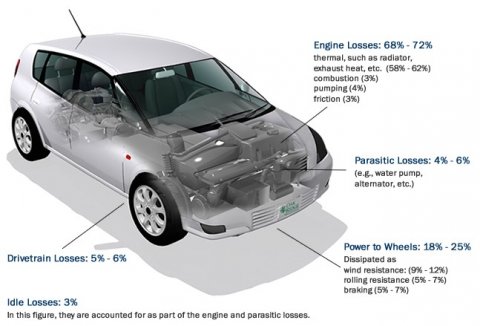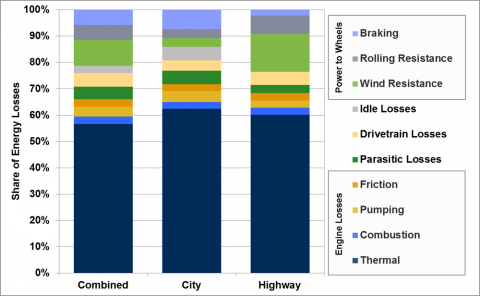Not all of the fuel that is put into a car's fuel tank is used to move the car down the road. In fact, only 14-30% of the energy put into a conventional car is used for that purpose. The rest of the energy is lost to engine inefficiencies or used to power accessories. The amount of energy losses is different depending on the type of driving – city, highway, or combined city and highway. The engine losses, such as exhaust heat and pumping, are higher for city driving than for highway driving. There are no idle losses in highway driving, but losses due to wind resistance and rolling resistance are higher for highway driving than city driving. All in all, there is great potential to improve vehicle fuel efficiencies with advanced technologies that address these losses.
Energy Losses for a Conventional Vehicle for Combined City and Highway Driving
Energy Losses for a Conventional Vehicle for City, Highway, and Combined Driving
Supporting Information
| Types of Losses | Types of Driving | ||
|---|---|---|---|
| Combined | City | Highway | |
| Engine Losses | 68-72% | 71-75% | 64-69% |
| Thermal - radiator, exhaust heat, etc. | 58-62% | 60-64% | 56-60% |
| Combustion | 3% | 3% | 3% |
| Pumping | 4% | 5% | 3% |
| Friction | 3% | 3% | 3% |
| Parasitic Losses, e.g. water pump, alternator, etc. | 4-6% | 5-7% | 3-4% |
| Power to Wheels, dissipated as: | 18-25% | 14-20% | 22-30% |
| Wind Resistance | 9-12% | 3-5% | 13-19% |
| Rolling Resistance | 5-7% | 3-5% | 6-9% |
| Braking | 5-7% | 7-10% | 2-3% |
| Drivetrain Losses | 5-6% | 4-5% | 4-7% |
| Idle Losses | 3% | 6% | 0% |
Source: U.S. Department of Energy and U.S. Environmental Protection Agency, Fuel Economy Guide website. | |||



